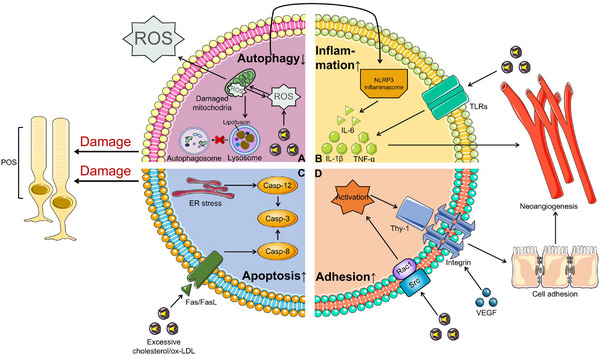FIGURE 2.

Effects of the accumulation of excess cholesterol/ox‐LDL in AMD. Excessive cholesterol is easily oxidized to ox‐LDL in the retina, which is the main component of 7KCh and widely affects multiple cellular processes. (A) First, under the condition of excessive lipid accumulation, oxidative stress can be triggered, leading to the mitochondrial damage in RPE cells, thereby increasing oxidative stress. Finally, some oxidation products polymerize, and lipofuscin accumulates in the lysosomes of cells, affecting the phagocytosis of lysosomes against autophagy and resulting in the impact on autophagy in the POS. In addition, decreased autophagy and mitochondrial damage can activate NLRP3 inflammasomes and further release inflammatory factors. (B) Second, excessive cholesterol activates NF‐κB pathway by binding to TLRs, increasing the expression of inflammatory factors, such as IL‐6, IL‐1β, and TNF‐α. (C) Third, the activation of Fas/FasL signals and ER under stress can increase the activities of Caspase‐3, ‐8, and ‐12 that promote apoptosis, leading to the increase of apoptosis of POS. (D) Fourth, the activation of Rac1 and Src by 7KCh leads to VEGF‐dependent expression of Thy‐1 and induces cell adhesion and migration, resulting to vascular rupture and angiogenesis with the increased expression of inflammatory factors. TLRs, Toll‐like receptors; VEGF, vascular endothelial growth factor; FasL, Fas receptor‐Fas ligand; POS, outer segment photoreceptor; NLRP3, NOD‐like receptor protein 3.
